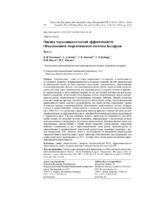| dc.contributor.author | Романюк, В. Н. | |
| dc.contributor.author | Бобич, А. А. | |
| dc.contributor.author | Рыжова, Т. В. | |
| dc.contributor.author | Бубырь, Т. В. | |
| dc.contributor.author | Янчук, В. В. | |
| dc.contributor.author | Яцухно, Я. С. | |
| dc.coverage.spatial | Минск | ru |
| dc.date.accessioned | 2023-02-09T13:14:17Z | |
| dc.date.available | 2023-02-09T13:14:17Z | |
| dc.date.issued | 2023 | |
| dc.identifier.citation | Оценка термодинамической эффективности Объединенной энергетической системы Беларуси. Часть 1 = Assessment of Thermodynamic Efficiency of the Belarusian Energy System. Part 1 / В. Н. Романюк [и др.] // Известия высших учебных заведений и энергетических объединений СНГ. Энергетика. – 2023. – № 1. – С. 44-56. | ru |
| dc.identifier.uri | https://rep.bntu.by/handle/data/126119 | |
| dc.description.abstract | Энергосистема – одна из основ современного государства, и необходимость ее успешного развития и функционирования не подлежит сомнению. В этой связи актуален ее объективный анализ на базе комплекса показателей: экономических, энергетических и термодинамических. Вместе с тем традиционная оценка работы энергосистемы осуществляется на основе таких характеристик, как удельный расход условного топлива на выработку электроэнергии и отпуск тепловой энергии, что не дает полной картины и не всегда применяется корректно. В настоящей статье впервые на базе эксергетического метода рассматривается расчет эксергетического коэффициента полезного действия. Данный показатель позволяет наиболее простым способом получить объективную оценку термодинамической эффективности такого сложного формирования, как энергосистема современной страны. В качестве примера проанализированы Объединенная энергетическая система Беларуси в целом и конденсационные электростанции в частности за достаточно продолжительный срок (2000–2021) и в различные характерные периоды времени. Описана методика расчета эксергетического коэффициента полезного действия. Полученные результаты представлены в графическом виде. Уделено внимание вопросу приемлемости погрешности при обобщении данных об исходных потоках первичных энергоресурсов и продуктовых потоках централизованных генерирующих источников энергосистемы. Проанализирован вклад конденсационных электростанций в общий объем генерации электроэнергии, определены наиболее совершенные из них с термодинамической точки зрения. Проведен расчет их энергетических и эксергетических показателей, рассмотрены изменения, связанные с вводом Белорусской АЭС. Делается вывод о целесообразности дальнейшей реконструкции энергоисточников энергосистемы с целью снижения относительного веса природного газа в приходной части энергобаланса до 50 %. Достичь этого можно путем повышения термодинамической эффективности. | ru |
| dc.language.iso | ru | ru |
| dc.publisher | БНТУ | ru |
| dc.title | Оценка термодинамической эффективности Объединенной энергетической системы Беларуси. Часть 1 | ru |
| dc.title.alternative | Assessment of Thermodynamic Efficiency of the Belarusian Energy System. Part 1 | ru |
| dc.type | Article | ru |
| dc.identifier.doi | 10.21122/1029-7448-2023-66-1-44-56 | |
| local.description.annotation | The energy system is one of the foundations of a modern state, so, the need for its successful development and functioning is beyond doubt. In this regard, an objective assessment based on a set of indicators (viz. economic, energy and thermodynamic) is relevant. However, the traditional assessment of the operation of the energy system is carried out on the basis of such characteristics as the specific consumption of conventional fuel for electricity generation and heat release, which does not provide a comprehensive picture and is not always applied correctly. In this article, for the first time on the basis of the exergetic method, the calculation of the exergetic efficiency is considered. The use of this indicator makes it possible to obtain an objective assessment of the thermodynamic efficiency of such a complex formation as the energy system of a modern country in the easiest way. As an example, the unified energy system of Belarus in general and condensing power plants in particular have been analyzed for a fairly long period (2000–2021) and in various characteristic time periods. The method of calculating the exergetic efficiency is described. The results obtained are presented graphically. Attention is paid to the issue of the acceptability of the error when generalizing data on the initial flows of primary energy resources and product flows of centralized generating sources of the energy system. The contribution of condensing power plants to the total volume of electricity generation is analyzed, the most advanced of them are determined from a thermodynamic point of view. The calculation of their energy and exergetic indicators was carried out; the changes associated with the commissioning of the Belarusian NPP were considered. The conclusion is made that further reconstruction of energy sources of the power system in order to reduce the relative weight of natural gas in the incoming part of the energy balance to 50 % is expedient. This can be achieved by increasing the thermodynamic efficiency. | ru |

